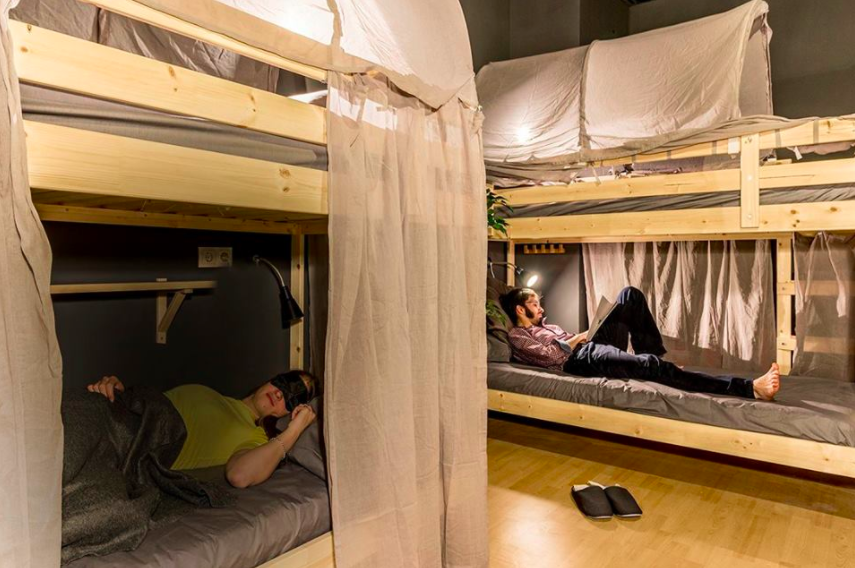Siesta & Go review: What happens when you pay for an afternoon nap in Madrid city centre
Madrid’s hottest new opening is a place where you can book in for a quick siesta. Stephen Phelan tries it out

There was a time when the whole kingdom of Spain fell asleep every afternoon as if drugged or bewitched. In some corners of the country – small towns, certain islands – the siesta remains a natural law, like gravity, pulling down shutters and eyelids against the heat of the day. These days, its grip on big cities is weakening – especially in the capital, where working hours don’t allow for the long lunches and leisurely naps of old.
But here in Madrid, in the gleaming futurist business district of Nuevos Ministerios, the outmoded concept of daylight dozing has been revived by a new startup. Open daily from 11am to 7pm, Siesta & Go is a “nap bar” that rents out beds by the minute, as well as comfy armchairs with foot pouffes and quiet workspaces where you can nod off and faceplant into your keyboard without fear of reproach.
The health benefits of a good siesta are extolled in the promotional blurb – relief from tension, enhancement of creative faculties, reduced risk of heart attack, increased “luminosity and freshness”. According to its website, studies show that a siesta can even help “prevent ageing and prolong life with a repairing effect that fights free radicals”.
Not being Spanish, I wasn’t raised to sleep while the sun shines. But as a long-time freelancer, well used to working from home, I’ve turned into a semi-professional napper, and consider myself supremely qualified to evaluate the place.
If I can find it, that is. This so-called “relaxation centre” is tucked into the shadows of Madrid’s tallest office towers, enclosed by a dystopian maze of subterranean shopping arcades, concrete tunnels and split-level concourses where my 4G phone-map keeps losing my location. Pretty agitated by the time I stumble across the entrance, I am soothed by a friendly attendant named Joan.
He offers me a private room at 23 cents (20p) per minute, but I go for the more basic option, an upper bunk in an open dorm for 13 cents (11p) a minute – €8 for a full hour. You can also block-book for repeat visits at discounted rates, with inclusive coffee and snacks. Joan says Siesta & Go already has regulars who pop in every day to occupy a bed, chair or desk for as long as they can afford to – students, shift-workers and frequent travellers en route to or from Barajas airport.
It’s a haven for them, he suggests. “Like a hiding place.” He gives me free earplugs and slippers (eye-masks, hairbrushes, dental kits and various hand and face creams are available for sale), and leads me to my assigned slot in the main chamber. The interior is dark, cool and quiet, with rows of bunks that look like cocoons under veil-like partitions and dim reading lights. It reminds me a little of the hospital basement where mad doctors harvest live bodies in 1970s sci-fi movie Coma.
The security cameras in the corners are vaguely disconcerting, but make sense in a mixed-gender dorm. My bigger fear is that not so different from the backpacker hellholes of my youth in terms of the animal sounds and smells emitted by others in their slumber. As it happens, I can’t tell if I’m alone in here, or entirely surrounded. I can only detect a pleasant pine scent from the timber-cut bedframes. Climbing up my stepladder; lying down on fresh sheets and fluffy, textured pillows (which are changed after every guest); plugging out the ambient noises of circulating city traffic and high-powered air-conditioning, this feels more like entering a sensory deprivation tank.
I had also been concerned that I might disturb my fellow day-sleepers. My napping style is similar to my dog’s – all growls and whimpers and twitchy legs. I suffer from odd attacks of sleep apnea that make me sit up and hiss as if staked through the ribs by a vampire hunter. Self-conscious about this, I just lie still and mindful for a while, then sink into a dormant, twilight standby mode, like the half-awake state you often drift into on long bus or train journeys. I’m under just deep enough for one brief, boring dream about waiting for a table in a busy Viennese cafe. But I’m also far gone enough to lose all sense of time and place.
Siesta & Go patrons have free wi-fi and the option of setting their own alarms. I prefer to go the whole hog, and turn my phone off, having taken Joan up on his offer to wake me after an hour.
Being woken up by Joan whispering in my ear and gently tapping me on the shoulder could be creepy. But thanks to his kindly, monkish bedside manner, it isn’t at all.
On the way out, I remember what he said about people hiding in here. The appeal, it seems to me, is not just the promise of the siesta itself, but the prospect of disappearing from the world.
Your little blue blip can vanish off the map for as many minutes as you like. But until Joan wakes you up, you get to absent yourself from the blare and glare of waking life. You are nowhere. You are not to be found.
Join our commenting forum
Join thought-provoking conversations, follow other Independent readers and see their replies
Comments